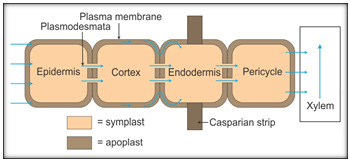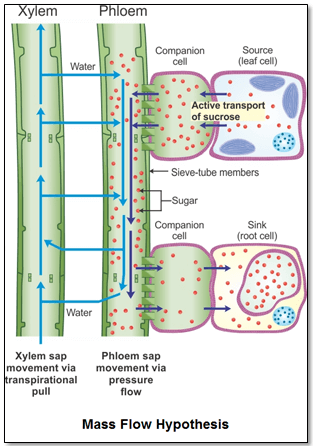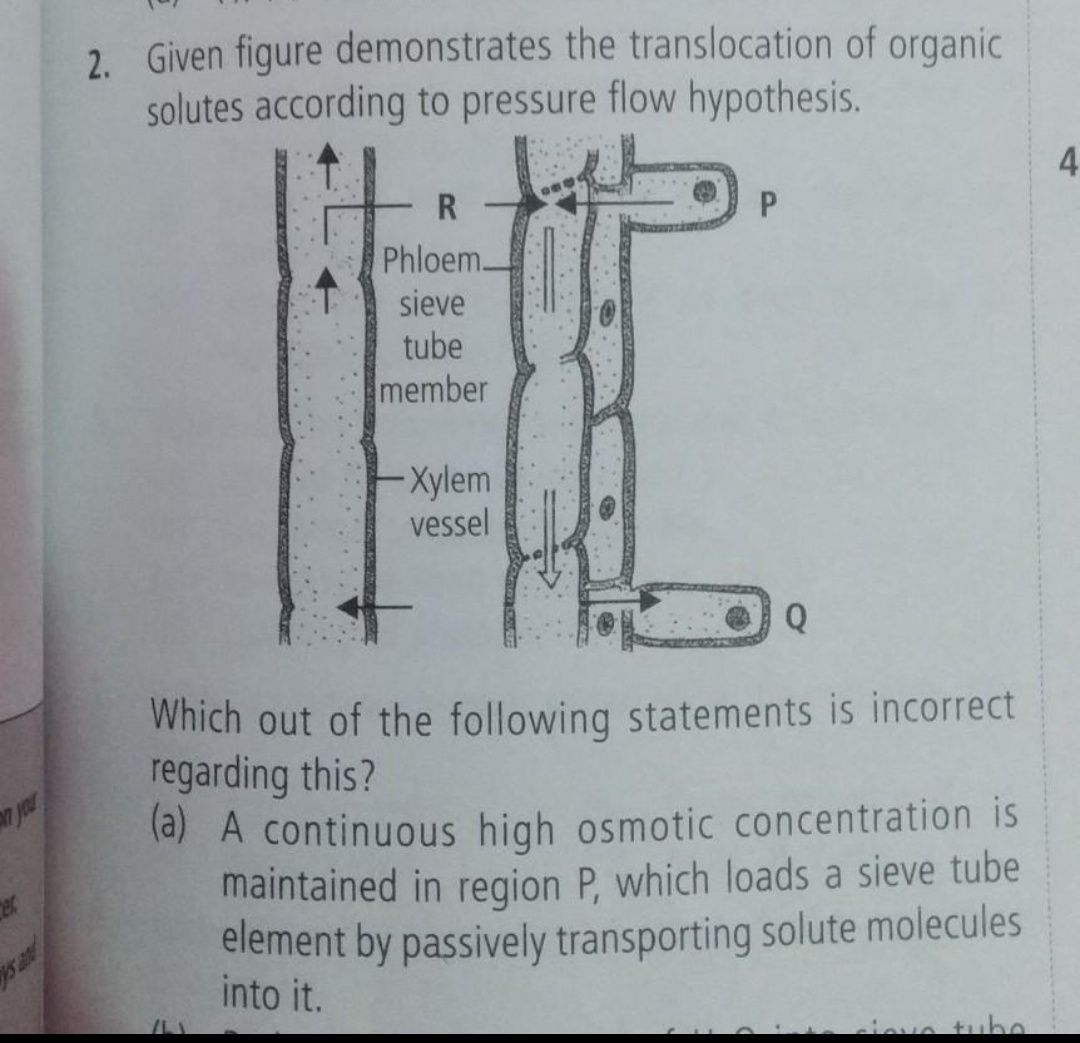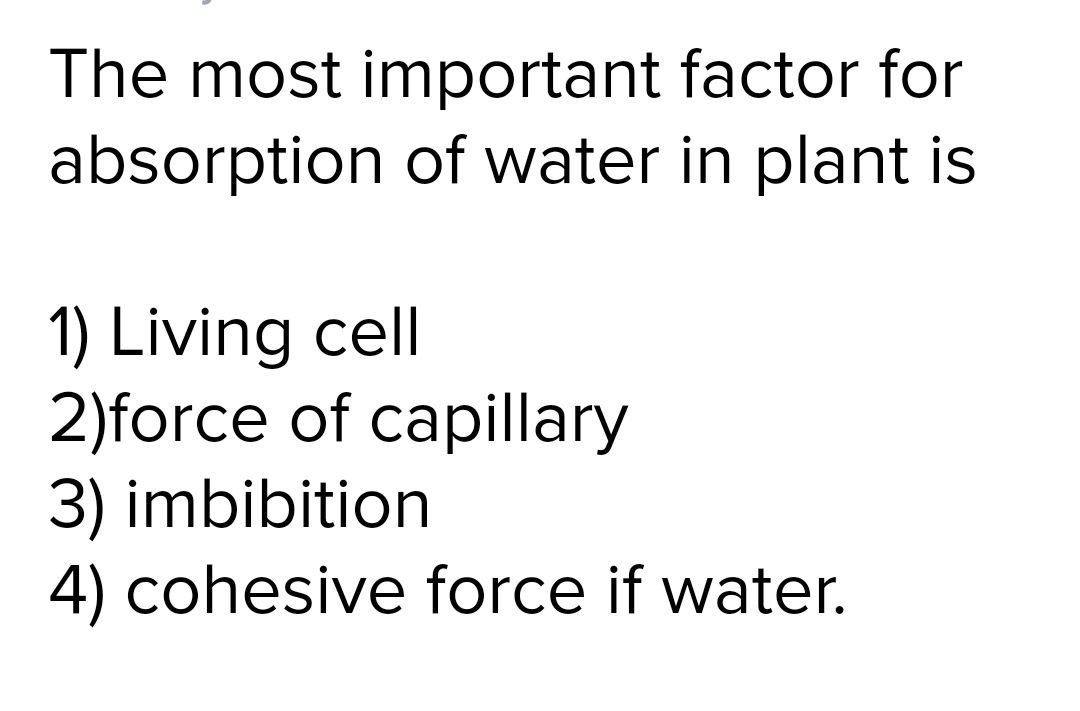Transport in Plants
Transport in Plants PDF Notes, Important Questions and Synopsis
SYNOPSIS
- Transport Mechanisms in Plants
Property
Simple Diffusion
Facilitated Diffusion
Active Transport
Requires special membrane proteins
No
Yes
Yes
Transport saturates
No
Yes
Yes
Highly selective
No
Yes
Yes
Uphill transport
No
No
Yes
Requires ATP energy
No
No
Yes
-
The difference between the free energy of water molecules in pure water and the energy of water in any other system is termed water potential (ѱw).
-
The amount by which the water potential is reduced as a result of the presence of solute is called the solute potential or osmotic potential (ѱs).
-
Pressure potential (ѱp) is the positive pressure developed in a system because of osmotic entry of water into it.
-
Osmotic pressure is the pressure required to prevent the passage of pure water into an aqueous solution through a semi-permeable membrane, thereby preventing an increase in the volume of the solution.
-
Turgor pressure (TP) is the pressure developed in an osmotic system because of the entry of water which causes swelling of the system.
-
Plasmolysis is the withdrawal of protoplast of a plant cell from its cell wall because of excessive loss of water from the cell.
-
Imbibition is the phenomenon of adsorption of water or any other liquid by solid particles of a substance without forming a solution.
-
A mass flow or bulk flow system is responsible for the movement of substances in bulk or en mass from the sites of production or adsorption to the sites of storage or consumption as a result of pressure differences between the two sites.
-
Bulk flow can be achieved through either a positive hydrostatic pressure gradient or a negative hydrostatic pressure gradient.
-
Pathways for the Movement of Water along the Roots
- Apoplast pathway: Water moves from the root hair to the xylem through the walls of intervening cells without crossing any membrane or cytoplasm. This movement of water occurs through bulk or mass flow.
- Symplast pathway: The water entering the cell sap of root hair moves into the underlying cortex cells through plasmodesmata. The Casparian strip blocks the movement of water and minerals from one side to the other side via the cell wall route. Therefore, water can reach up to the endodermis through the apoplast, but it moves through the endodermis by the symplast.
- Ascent of Sap
-
Root Pressure: Hydrostatic pressure developed in the roots because of the continued inward movement of water through cell-to-cell osmosis which helps in the movement of ascent of cell sap upwards through the stem.
-
Transpiration Pull: Continuous loss of water from the leaves due to transpiration makes mesophyll cells absorb water from the adjacent internal mesophyll cells and compensate for the loss of water. This loss causes a water deficit in the xylem.
-
Cohesion-Adhesion Forces: The forces are responsible for maintaining unbroken continuity of the water column from the roots to the leaves. This water column is pulled upwards continuously without breaking, from the roots to the leaves by transpiration.
-
Uptake and Translocation of Mineral Ions:
- Specific proteins in the membranes of root hair cells actively pump ions from the soil into the cytoplasm of the epidermal cells.
- Transport proteins of endodermal cells are control points which decide the quantity and the types of solutes which reach the xylem.
- The absorbed mineral ions move laterally from the epiblema to the xylem through the cortex, endodermis and pericycle, from where they are transported upwards through the xylem along with the transpiration system.
- Mass Flow Hypothesis
- The accepted mechanism used for the translocation of sugar from source to sink is called mass flow hypothesis or pressure flow hypothesis.
- It is achieved via active transport.
Related Chapters
- The Living World
- Biological Classification
- Plant Kingdom
- Animal Kingdom
- Morphology of Flowering Plants
- Anatomy of Flowering Plants
- Structural Organisation in Animals
- Cell : The Unit of Life
- Biomolecules
- Cell Cycle and Cell Division
- Mineral Nutrition
- Photosynthesis in Higher Plants
- Respiration in Plants
- Plant Growth and Development
- Digestion and Absorption
- Breathing and Exchange of Gases
- Body Fluids and Circulation
- Excretory Products and their Elimination
- Locomotion and Movement
- Neural Control and Coordination
- Chemical Coordination and Integration
- Reproduction in Organisms
- Sexual Reproduction in Flowering Plants
- Human Reproduction
- Reproductive Health
- Principles of Inheritance and Variation
- Molecular Basis of Inheritance
- Evolution
- Human Health and Disease
- Strategies for Enhancement in Food Production
- Microbes in Human Welfare
- Biotechnology : Principles and Processes
- Biotechnology and its Applications
- Organisms and Populations
- Ecosystem
- Biodiversity and Conservation
- Environmental Issues







